P&O’s
SS Chitral & Cathay, ex Jadotville & Baudouinville
Please
Note: Firefox and some other search engines are not
suitable – Use “Internet Explorer” for this page
to load perfectly!

Click
the logo above to reach the ssMaritime FrontPage for News Updates
& “Ship of the Month”
Please
Note: All ssMaritime and other related maritime/cruise sites
are 100% non-commercial and privately owned. Be assured that I am
NOT associated with any shipping or cruise companies or any
travel/cruise agencies or any other organisations! Although the
author has been in the passenger shipping industry since 1960,
although is now retired but having completed around 680 Classic
Liners and Cargo-Passengers Ships features I trust these will
continue to provide classic ship enthusiasts the information the
are seeking, but above all a great deal of pleasure! Reuben
Goossens.
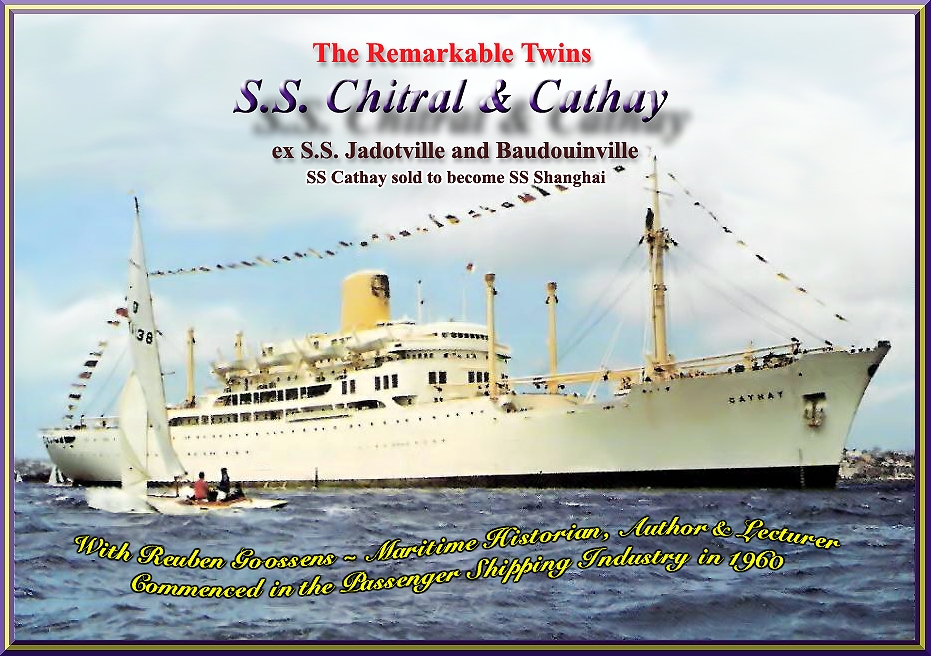
Please
Note: Photographs, Postcards & brochures are from the
author’s private collection, unless stated otherwise.
Most
of these remain in his collection from his agency days
Introduction:
As a maritime historian I am delighted to be
able to write on these two delightful ships online, for I
recently discovered that nobody has bothered to do so in the past
have astonished me! I have admired the Belgian as well as other
passenger cargo fleets ever since I was a youth and thus I have
written on many Combi-Liners over the years and had intended to
write on these two fine ships being the very last “Belgian
Congo-Liners” ever to be built in due course! Due to
declining health it slowed down my progress, however, I am
delighted to present the SS Cathay and Chitral now in September
2013.
Enjoy! Reuben Goossens.
Introduction:
In mid 1950s “Compagnie Maritime
Belge” built two remarkable ships, which were the very last
of a very long line of Belgium passenger-cargo ships designed
especially for the famed Congo service, the ex SS Jadotville and
Baudouinville III. And in this feature I will be revealing a
great deal about these two remarkable ships!
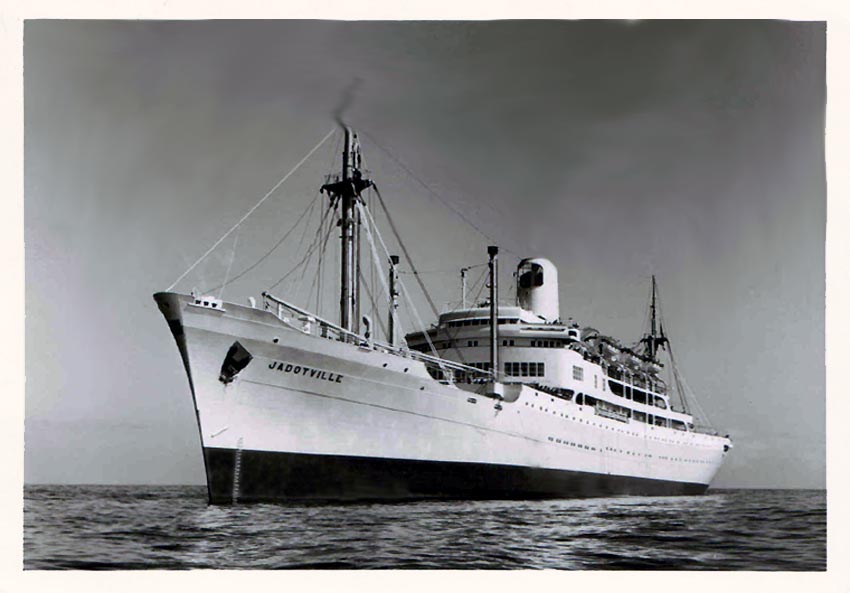
An
early postcard of Compagnie Maritime Belge’s SS Jadotville
Looking
Back:
“Cie Maritime Belge” was founded in
1895 under the name “Compagnie Belge Maritime du Congo”
(CBMC). At the request of King Leopold II of Belgium and with
support from British investors, a maritime connection was opened
with the “Congo Free State.” Their very first ship the
Leopoldville departed on her maiden voyage on February 6, 1895
and she was the company’s first ship to leave the port of Antwerp
bound for the Congo. Interestingly, it had been for some sixty
years that the Dutch “Kongoboten” Congo boats, had been
present in the Port of Antwerp, as the Dutch ruled the oceans
over the years, even more so than the British, thus the reason,
the British invested into the Belgium Company!
In 1930 CBMC purchased another Belgium company
“Lloyd Royal Belge,” and the company name was shortened
to “Cie Maritime Belge” (CMB), mostly due to new
services having been obtained towards America as well as the Far
East. But amazingly the company had become closely associated
with some thirty-two “Ville” ships operating between Antwerp
and the Belgian Congo and that was quite an achievement!
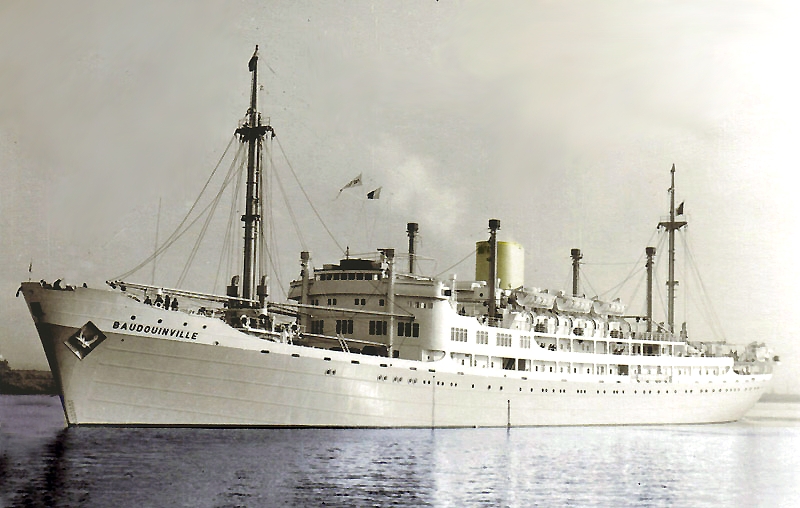
SS
Baudouinville II was launched on March 4, 1950 and
she
departed on her Maiden voyage September 7, that same year
Between 1948 and 1951 the company built the
famed five 10,900-ton luxury “Albertville Class” ships,
being the; M.S. Albertville, Elisabethville, Leopoldville,
Baudouinville, that was later renamed Thysville because of the
new Baudouinville being one of the ships being the subject matter
of this feature, and finally the Charlesville, which was the last
to be completed in 1951.
Their
Two Final Passenger-Cargo Liners:
CMB, or as they were also known as; Lloyd
Royal, decided to build two brand new, but larger 13,800 ton
liners and these ships differed to their predecessors having a
taller amidships superstructure with a modern tall funnel and a
shapely bow and having delightfully slender streamlined lines.
They were perfectly designed ships and their interiors were like
all CMB ships being offering a most pleasing and a beautiful
décor throughout!
Ship One: Both ships were built at
different shipyards, one in Belgium and the other in France. The
first of the pair, the SS Jadotville was built by at one
of the most famous ship yards that had built some of the most
greatest ships the world had ever known: The yard is the famed
Chantiers de Penoët at St Nazaire, France, which was the very
same shipyard that built such great French liners as the SS Paris
(1916), the beautiful and glamorous SS Ile-de-France (1925) and
the greatest liner of them all, the SS Normandy (1932) were
built! And this rather small, but elegant passenger-cargo liner
was also built here as was her steam engines.
Ship Two: The second of this delightful
pair, being the, SS Baudouinville was built at the long
established and well known, J. Cockerill S. A. at Hoboken,
Belgium a most illustrious yard that had built so many of the
companies ships in the past!
SS Jadotville was launched from the Chantiers
de Penoët slipway on November 30, 1955 and having been fitted
out and completed, she headed off for her sea trails in June 17
to 19, 1956. She was delivered to her owners on July 8, and then
after she had been made ready with crew, cargo and with her
passengers on board she departed for her maiden voyage from Antwerp
to Matadi the Belgium Congo, on July 23, 1956 and she continued
sailing without any mishaps.
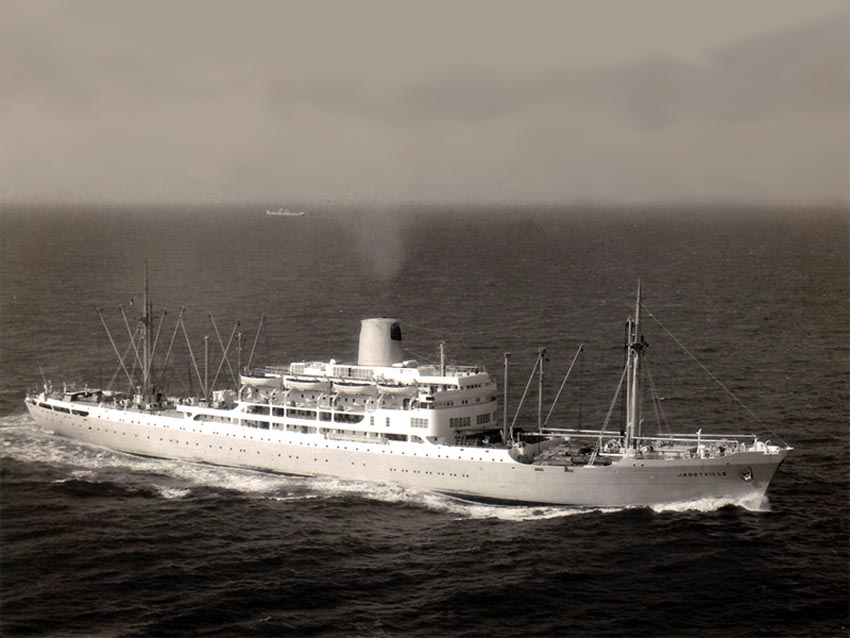
A
wonderful photograph of the SS Jadotville is seen during her sea
trails on June 18, 1956
SS Baudouinville was launched in Hoboken
Belgium on January 10, 1957 and she ran her sea trails on October
17 to 19 and was delivered soon after. She departed on her maiden
voyage from Antwerp to the Belgium Congo on November 2, 1957 and
she like her sister operated successfully!

A
wonderful photograph of the delightful SS Baudouinville III
Cargo
Capacity and Interiors:
These two ships were perfectly balanced for
their duties, having comfortable all outside cabins for 274 adult
passengers and 24 children as well as having six holds with a
capacity for a good 532,500 cu. ft of cargo, as well as 16,600
cu. ft of refrigerated goods.
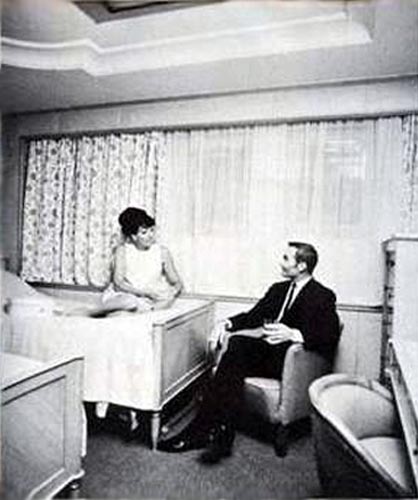
A
twin bedded suite
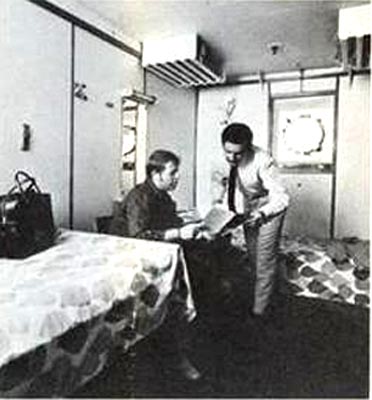
Two
berth cabin
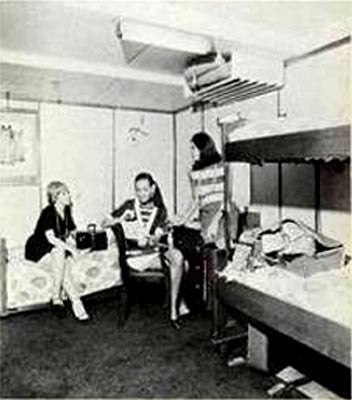
Three
berth cabin
For passenger comfort these ships included a
beautiful and spacious Main Lounge with a dance floor, an elegant
Smoking Room with a Bar, a Library and Writing Room, as well as
the ever-popular aft Verandah Café with large floor to ceiling
windows along the aft wall overlooking the Swimming Pool and the
aft Sports Decks. There was also a shop, the Pursers Office and a
hairdressing Salon, a Cinema and a Children’s playroom with
a play deck. The ship offered ample deck spaces,
Below there was the spacious full width dinning
room, whilst accommodations on offer varied from single to twin
bedded rooms, to three or four berth cabins, having a bathroom
with a bath or a shower.
A
Sudden Change was at Hand!
However, both ships would not sail for the
company for very long as both ships were placed on the market
late in 1960. This was due to the Congo having entered into a
vicious civil war, thus ending their services were forced to end.
CMB, where able to reschedule some of their much-loved older
ships, which continued to sail on well into the 1970s, but it was
thought that in these tougher financial times that these two new
ships would bring the company a far better and a high price, thus
they had to be sacrificed!
Below you will find the specifications of the
two ships in question. I have given two numbers (1) &
(2) to cover the two ships and they are as follows:
(1)
= SS Jadotville became the Chitral:
(2)
= SS Baudouinville became the Cathay, later - Kengshin
& Shanghai:
GRT = Gross Registered Tons.
Specifications:
Built
by:
(1) Chantiers de Penoët at St Nazaire, France.
.
(2) J. Cockerill S. A. Hoboken, Belgium.
Yard:
(1) Nr. 516.
.
(2) Nr. 778.
Launched:
(1) November 30, 1955.
.
(2) January 10, 1957.
Trials:
(1) June 19 to 17, 1956.
.
(2) October 17 to 19, 1957.
Maiden
Voyage:
(1) July 23, 1956.
.
(2) November 2, 1957.
Tonnage:
(1) 13,724 GRT - 13,821 GRT - 1961.
.
(2) 13,922 GRT - 13,809 GRT - 1961 - 13,531 GRT - 1969.
Length:
(1) 169.8m / 557ft.
.
(2) 170.5m / 559ft.
Width:
21.4m / 70.2ft.
Draught:
28.2ft / 8.6m.
Engine:
Steam - D.R. Geared Turbine engines by their builders.
Screw:
Single - 12.500 SHP.
Speed:
16.5 knots, maximum of 18 knots.
Passengers:
300 passengers.
Crew:
196.
P&O
London:
P&O Line in London heard that these
excellent ships had become available and they moved quickly and
purchased both ships for just £3 million Pounds, being a
bargain, considering these passenger-cargo liners were under five
years old. Jadotville and Baudouinville were renamed, SS Chitral
and Cathay respectively and were sent off for a refit.
However, P&O decided that only a minor
refit was required when it came to their public venues and
accommodations, as they were already of the very highest standard
and first class, thus it was mostly soft furnishing changes!
A Deck-by-Deck description of the Ships:
We are now going to have a look at a
Deck-by-Deck description and I will commence topside and always
commence forward to aft where applicable: Also, please note that
the description is based on the SS Cathay as the Chitral may have
slight variances?
Upper Boat Beck:
This deck can only be reached via the stairs on
each side of the aft superstructure on A (Promenade) and Boat
Decks and this deck is the highest location where you would have
found the Swimming Pool and Lido Deck. Besides the Pool, there
were showers and toilets on the portside, whilst there was also a
table tennis table on the starboard side. Both sides of this deck
had a fixed clear screen protecting guests from the winds!
Boat Deck:
This deck just offers deck space under the
lifeboats on both port and starboard sides; it was a pleasant
place to relax.
A (Promenade) Deck:
Located far forward and occupying the full
width of the ship is the Main Lounge, with curved slightly raised
and areas on both sides separated by metal balustrades topped
with timber railings. In the center was a dance floor with the
bandstand being located in the middle forward of the ship. Up on
the raise sections, there was seating for around 40 guests based
who would be seated on comfortable armchairs and sofas. Whilst in
the central section was further seating for around another 55
guests utilising armchairs, thus this venue could accommodate a
good 95 guests.
Directly aft was the main Lobby where the Lift
together with the fine timber stairwell went all the way down to
E Deck. Heading aft we arrive at the delightful and popular
Smoking Room that offered seating for 45 guests using deep
armchairs as well as sofas.
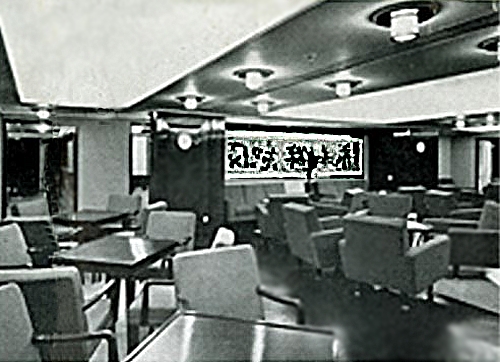
The
cosy and warm Smoking Room
Heading aft along the starboard side is the
Long Bar, it is mainly to serve the Smoking Room as well as the
venue aft, and thus it does not have a large seating capacity.
However, it does have seven barstools as well as six deep and
comfortable lounge chairs identical to those in the Smoking Room.
From here you enter the aft Lobby and its
curved stairwell that goes down as far as C Deck! Whilst on the
opposite side of the Bar, thus on the portside there is the
spacious Library, Writing and Reading Room with its comfy sofas,
deep and comfortable Lounge chairs as well as several writing
desks with accompanying chairs. Of course there where ample
timber bookcases stacked with a wide range of books suitable for
a long voyage!
We now reach the final venue aft on this deck
and this is the delightful Verandah Café, a venue that was an
old time standard on P&O-Orient Line ships and was so much
loved venue!
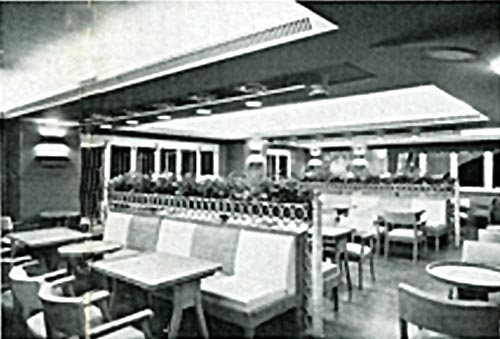
The
Verandah Café on the SS Cathay
It had that delightfully casual feel always
filled with plants and or palms; it was the perfect place for
that hot cup of morning bullion or a cup of English tea, or
possibly a coffee. This venue had wonderful views some through
the side windows, but the best were through the aft folding
screens, which during the warmer climes were opened up and the
entire aft wall would disappear providing a grand view of the
ships aft decks and the ships wake! Seating tended to be more
intimate as there were more tables for two, in fact at total of
12 seating 24, then there
On the forward port corner was the Piano for
entertainment as this venue was used for a variety of activities!
Externally, there was a covered Promenade Deck,
with open space aft ideal for sun baking or some sport
activities.
B Deck:
Internally this deck was mostly occupied with
accommodations. Forward on the starboard side was the deluxe
suite that had a bedroom and a lounge area with a spacious
bathroom with a full bathtub and all the other luxuries that a
suite would have!. To enter the suite, you would do so though its
very own vestibule! Also located far forward by in the middle was
“The Bureau,” or the Pursers Office, whilst on the
portside was the Pursers rooms, and his staff room.
All cabins on this deck were outside with a
window and they had private facilities, many with a bathtub,
whist others had a shower stall. This deck had 7 twin bedded
cabins, 25 single bed casbins and 5 three berth cabins, for a
total of 54 passengers
At the lobby was the spacious shop with the
Hairdressing Salon located on the portside aft. The aft of this
deck is the spacious Children’s Playroom with every possible
facility for the younger generation sailing on these ships. At
the rear of this room was a pantry, a toy locker and toilets for
the children. Then aft out on the deck on the port side was the
children’s paddling pool and enclosed playground.
C Deck:
Again all the cabins were outside but this time
with portholes, except for those few facing forward that had
windows. Cabins ranged from twin bedded, two-berth and
three-berth cabins to a few four-berth cabins. All those forward
had private facilities but with a shower, whilst cabins from the
aft lobby to the rear had no private facilities however there
were ample bathrooms with showers as well as spotess individual
bathrooms with bathtubs and toilets close by.
Thankfully P&O decided to reduce the
passenger capacity of both ships by sixty-nine berths to just 231
passengers on each ship, thus passengers had ample space and
great comfort for these long and exotic voyages!
Located aft of this deck was a Medical Centre,
which included a consulting room, a chemist as well as a spacious
hospital.
D Deck:
On this deck, which is reached via the forward
stairwell or the lift there is just one venue and it is without a
doubt the most popular venue on the entire ship! It is the
Restaurant that has thirty-seven tables and is it able to seat
all guests at the one sitting.
E Deck:
This deck is reached again via the forward main
Stairwell, as well as the Lift that reaches all decks from A
(Promenade) down to E Deck. You may ask, what is located of
interest here, well it as another very popular venue, it was the
ships very populat and much used Cinema! It had seating for 80
passengers, thus a movie would be repeated several times,
ensuring that all guest had the chance to see it!
This brings me to the end of the
Deck-by-Deck tour of the SS Cathay and the Chitral! See
Page Two for Lounge and other photographs from a 1961
P&0 Brochure as well as Menus and Deck Plans – The Link
is located at the bottom of this page.
Cargo Space:
Both the SS Chitral and the Cathay had room for
a considerable amount of cargo with six cargo holds, three
forward and three aft with a total space of 532,600 cu.ft, plus
16,700 cu.ft. of refrigerated cargo space.
Upon completion their tonnage registered as
being (1) SS Chitral - 13,821 and (2) Cathay -
13,809 GRT and registered in London England. Both were placed on
the London (Tilbury) to Yokohama service and the first of the
pair, the SS Chitral departed Tilbury on March 2, 1961 and headed
for Japan via Hong Kong and an assortment of ports sailing via
the Suez Canal, whilst her sister the SS Cathay departed on Aril
14, 1961.
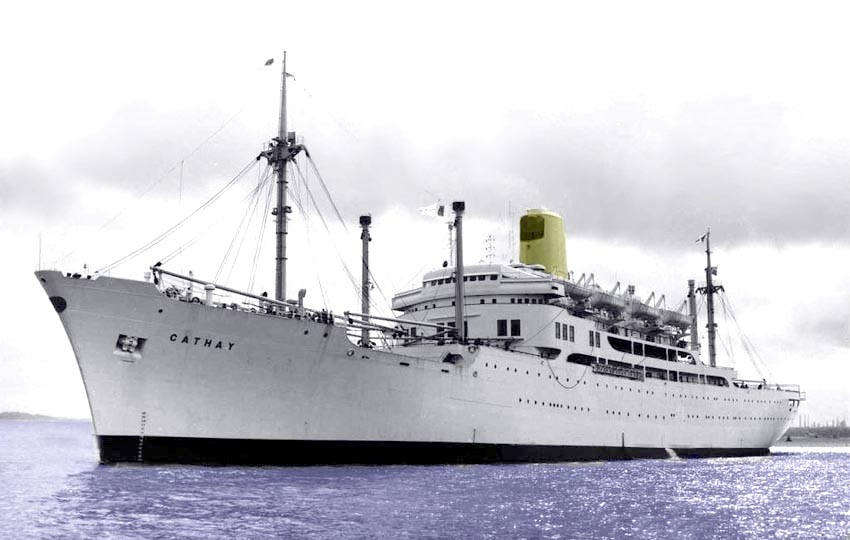
Above
& below: The almost identical P&O ships Cathay and
Chitral having entered the Japan service
But,
note their very different window configurations up on Promenade
Deck, the Chitral windows being more generous!
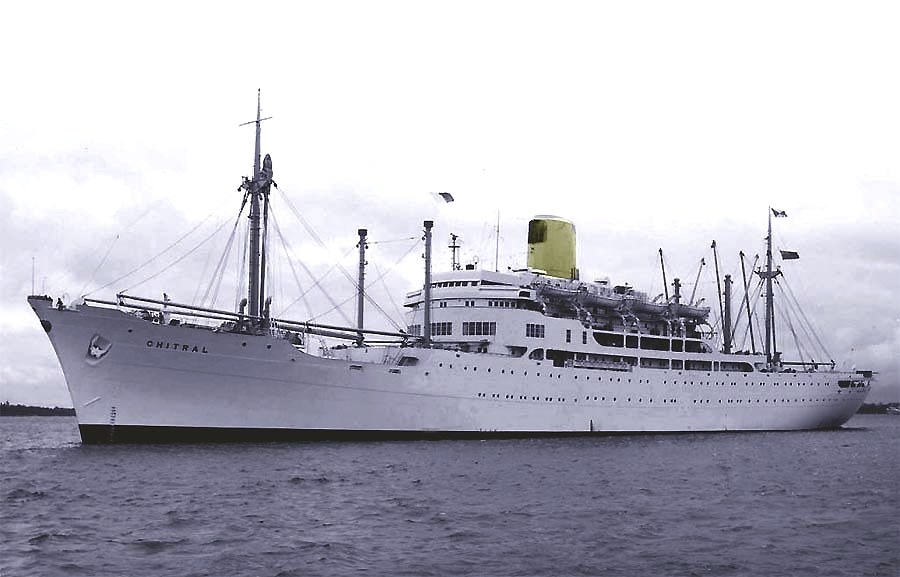
The service was going well and the ships were
much loved by their adventurous passengers, however one big
problem came suddenly about that would somehow change the course
of the success of these two ships on this service, and that was
the closure of the Suez Canal in 1967! This would mean that all
ships had a very long detour sailing all the way south around South
Africa, which was simply uneconomic for the Far East trade.
Thus the SS Cathay was the first to be
withdrawn in the middle of 1969 and given a comprehensive refit;
upon completion she was registered as being 13,531 GRT. She was
then transferred within the P&O’s long established
associate group, being the “Eastern & Australian
Steamship Company” (E&ASSCo) who had been operating the
ex Cunard liner Parthia, but after several refits was now named
SS Aramac, and this ship operated with great success on their
round voyages from Melbourne to Japan, but they required a more
modern and more economical ship and obviously the Cathay was the
perfect ship!
E&ASSC0:
Eastern & Australian Steamship Company
Ltd (E&ASSCo) had since World War II only been operating
as a cargo company, but in 1965 the perfect opportunity had come
to them, when the New Zealand Shipping Company’s SS Remuera
(built as the famed Cunard Line RMS Parthia) became available and
E&ASSCo obtained her in order to recommence its passenger
services. She was renamed Aramac and she became more popular than
the Remuera had ever been during her services from New Zealand to
the UK!
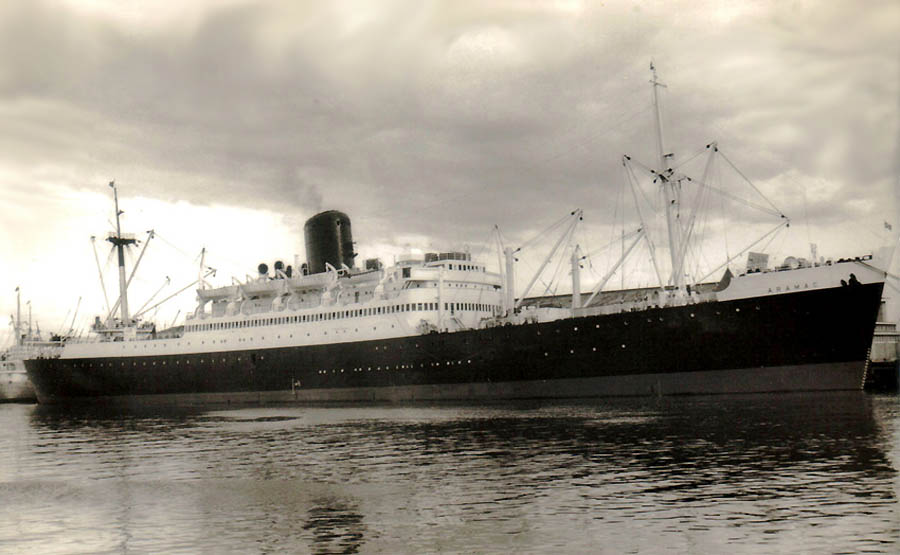
The
SS Aramac, ex Remuera & Parthia
Photograph
from an A. Duncan print, from the Rich Turnwald collection
SS Aramac’s new voyages to Asia and Japan
were advertised as Holiday Circle Cruises, sailing from Melbourne,
or from Sydney, or Brisbane to Japan and back! Advance sales were
even better than good and the ship continued to prove to be
extremely popular with her departing mostly fully booked! She
departed Melbourne on her first Yokohama voyage on February 8,
1965 and when she returned the ship came home with every single
passenger more than happy with their voyage and the experience.
In fact many came back as repeat passengers! But being this
popular, the ship in reality killed herself off, for the company
decided on a newer and an even better ship, which would be the Cathay!
The freshly refitted and modern Cathay headed
for Melbourne Australia and having arrived, she was made ready
and she departed for Sydney on December 13, 1969. The ports of
call were the same as those that the SS Aramac had made so
popular!
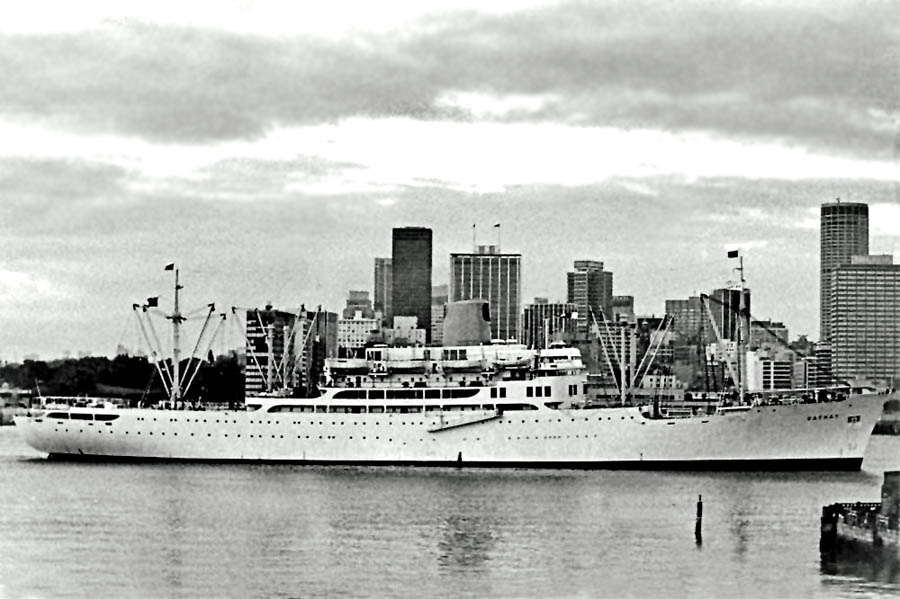
Here
we see the SS Cathay as she arrives in Sydney for the very first
time on December 15, 1969
Ports of call: Melbourne, Sydney, Brisbane,
Yokkaichi, Nagoya, Tokyo (Yokohama), Kobe, Keelung, Hong Kong, Manila.
Returning directly to: Brisbane, then back to Sydney and
Melbourne.
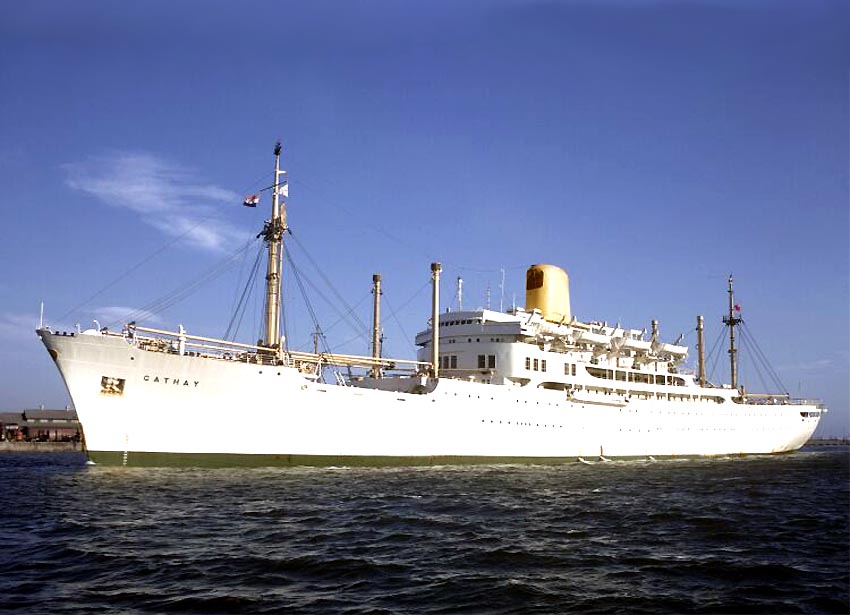
The
Cathay looking wonderful as she sails around Asia during a
Christmas cruise
Back in England the Chitral was also withdrawn,
but she was laid up and placed on the market and was for sale.
However, there were simply no offers for her, thus P&O used
her from March 1970 for a few Mediterranean cruises out of Genoa.
But, considering the huge success of the Cathay in Australia, it
was decided that it was best to transfer the Chitral to
E&ASSCo in Melbourne!
Thus the Chitral also joined the Cathay in Melbourne
in October 1970 and commenced on the Japan service with the same
success as the Cathay. These voyages were most profitable, not
just because of their passenger loadings, but also as these ships
had a large cargo and refrigerated capacity!
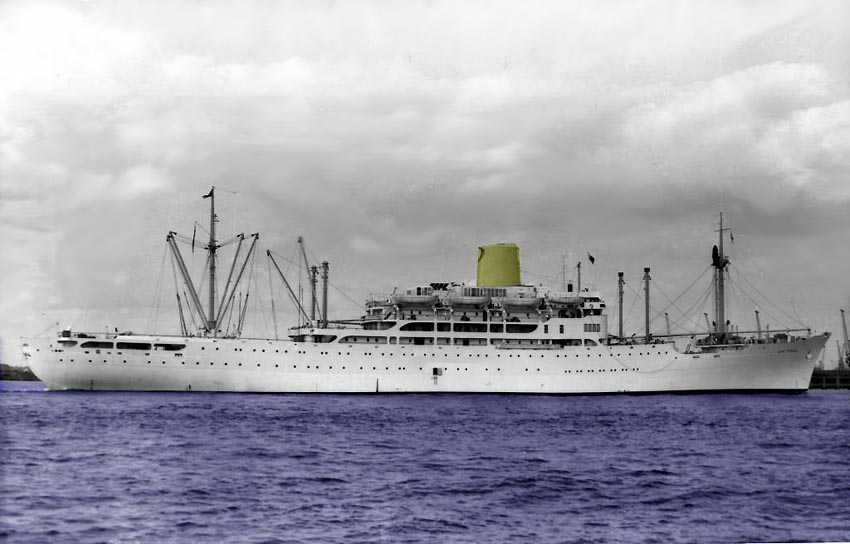
A
fine view of the SS Chitral
But sadly then came the time when fuel costs
were rising to very high levels and this combined with an
onslaught of competition in the Australia to Asia and Japan
service by companies who had been in this field for much longer
that any of the other companies would certainly have an adverse
effect on the Cathay and the Chitral. Yet, whist other ships that
were in this same service left the scene, both the Cathay and
Chitral remained popular, however they had to contend with two of
the most popular glamour ships that ever operated on this
service, being two famed Dutch twins, lovingly known as the
“Elegant White Yachts”, being the Royal Interocean
Lines (RIL) MS Tjiluwah and Tjiwangi. These two beautiful ships
were indeed the most elegant and luxurious small passenger-cargo
ships afloat at the time! The service and cuisine on these ships
were world famous and sadly the other ship just could not compete
with the style that these ships offered!
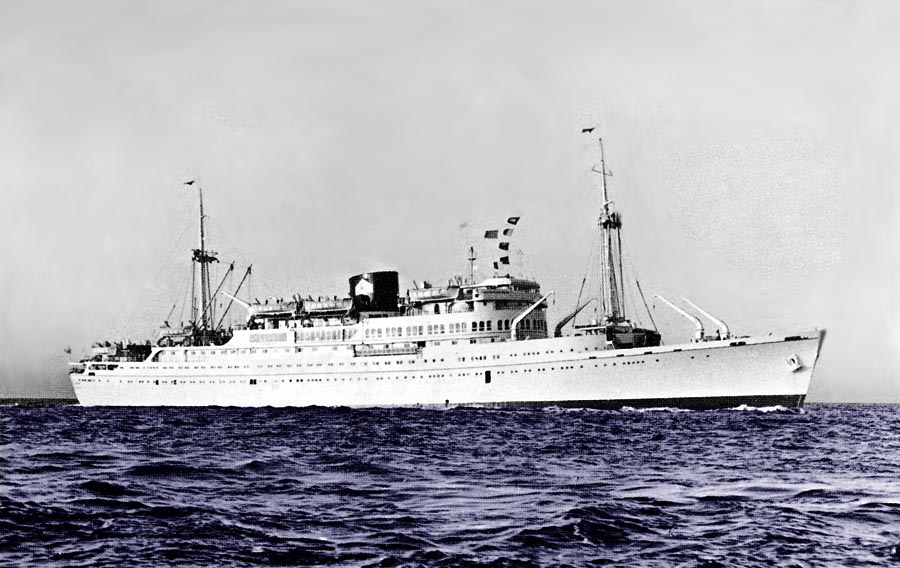
A
postcard of one of the “Elegant White Yachts”
On board passengers were spoiled with an
elegant grand staircases going down into the Dining Rooms of each
ship, which were two decks high whilst other elegant features
were the spacious Garden Terrace that surrounded the Main Lounge
& Ballroom located forward of the ships. Thus, the Aramac, Cathay
nor the Chitral could possibly compete with these two glamorous
and much loved “Elegant White Yachts.”
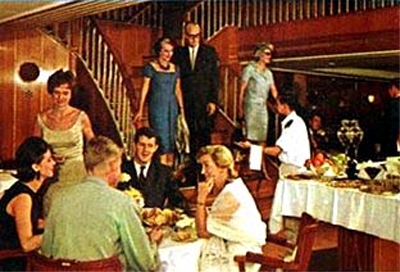
One
of the Restaurants on the MS Tjiluwah & Tjiwangi
But, when it came to cargo, all ships had one
new enemy and that was containerisation, and again the Dutch
ships relied more on passengers than cargo, but it would
eventually have an effect on all shipping!
Times were slowly getting difficult for the Cathay,
but things were far worse for the Chitral for she had been using
far more fuel than her sister. Thus E&ASSCo decided on
changing their scheduling and the Chitral was relocated to
Fremantle (Perth Western Australia) and she departed Melbourne on
January 14, 1972 and headed for Fremantle and sailed to
Singapore, Hong Kong, Keelung and visited all the Japanese ports
as per the regular schedule. She then returned via Manila, Bangkok,
Singapore, Bali, and Fremantle to Adelaide (South Australia).
Thereafter, she operated on this schedule for just two further
voyages, but sadly she simply was not popular and passenger
numbers were simply very poor indeed.
Eastern & Australian Steamship Company Ltd
(E&ASSCo) then decided to test the waters and the SS Chitral
would make two Trans-Tasman voyages to New Zealand visiting Auckland
on June 16 and August 1, 1975.
But tragically Chitral’s fuel problems was
getting really bad and thus it was finally decided by P&O
& E&ASSCo to sell her as soon as possible, for sadly the
SS Chitral had become completely unreliable and uneconomical for
her to continue.
However, with the decision to sell their
problem ship, what completely shocked the maritime industry and
prospective passengers was that P&O & E&ASSCo
suddenly announced that they had also decided to dispose of their
still popular and well booked SS Cathay, even though she was in
excellent mechanical condition, but the company stated that they
decided to do so because of the competition being mostly due the
Dutch ships popularity and the complete decline in cargo
bookings, thus they felt to sell both ships was the best option
at that time.
It was felt by many that their sale could well
mean the end of these two beloved ships, and for one these ships,
the Chitral it would certainly be the end, but not for the second
ship, the Cathay!
1…
The Chitral:
The 1956 SS Chitral, ex Jadotville was sold on
December 3, 1975 to a Taiwanese breaker and she headed for the
“Chou Iron & Steel Company” Breakers Yards at Hualien
in Taiwan and was duly broken up early in 1976. She was aged just
19½ years, if she had only been built in Belgium with her
sister!
2…
The Cathay:
The 1957 SS Cathay was a whole other matter,
for although most thought she would go the same way as the
Chitral, but nobody could have imagined that this ship had a long
life ahead of her, in fact another 21 years, which was longer
than she had been at sea to date!
The proud Cathay departed Melbourne on December
1, 1975 for her final voyage along the coast of Eastern Australia,
visiting both Sydney and Brisbane, and completed her voyage at Hong
Kong on December 17, where she remained. Eastern & Australian
Steamship Company had already placed her on the market knowing
full well that a good buyer would be found in Asia.
With the Cathay being in perfect condition she
was sold a month later, on January 28, 1976 to the Chinese
“Nab Yang Shipping Company” who renamed her “Kengshin”
and she was to be temporarily used as a training ship to train
Merchant Marine Officers.
SS
Shanghai 1976 to 1996:
However later in 1976 she was sold the
China’s giant shipping company, the “China Ocean
Shipping Company” or “COSCO,” which is based in
Shanghai and they renamed her the “Shanghai.” She was
given an extensive refit, giving her that more modest and
traditional Chinese interior style. She was very popular and she
usually departed a full ship. Food served on board was mostly
aimed at the local market, bit occasionally European’s would
send small groups on her and special menus would be prepared with
a special Asian evening for both the meal and entertainment, etc!
In 1984 and 2000 she was placed under different
management companies, such as the China Merchant Steam Navigation
Company Ltd, and she had either an all white livery to the
odd-looking green hull, but she was always very well maintained.
She sailed along the China coast to Hong Kong and she was seen in
Hong Kong Harbour on a frequent basis.
The
Shanghai Postcard Series
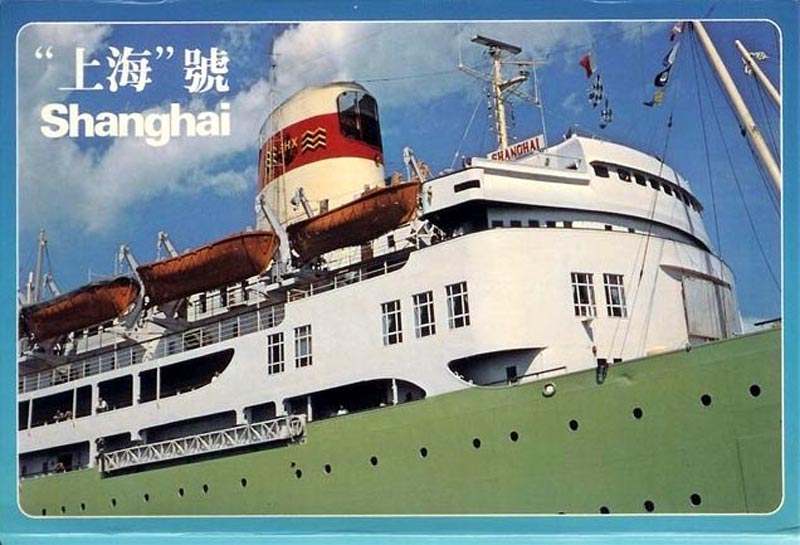
A
close up of the Shanghai with her new green hull, red lifeboats
and her yellow and red funnel
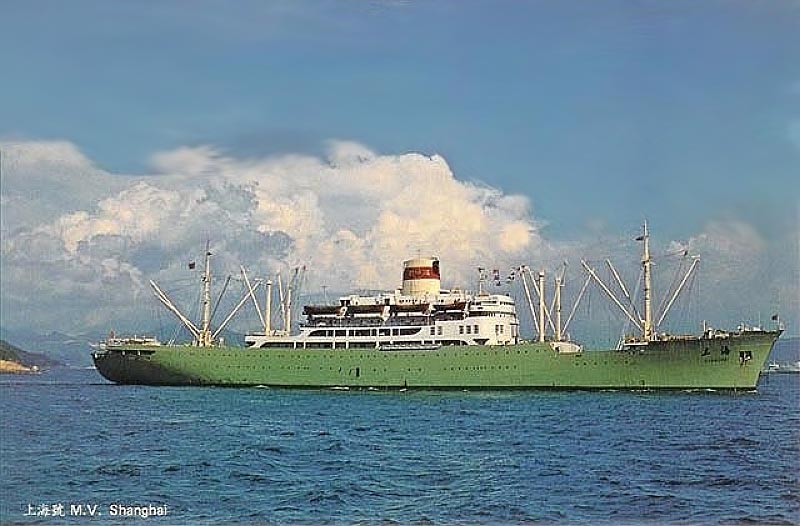
Her
we see the SS Shanghai with her all green hull and she looked a
very different ship indeed!
Although
she was a steam ship, the postcard showed M.V. for “Motor
Vessel”
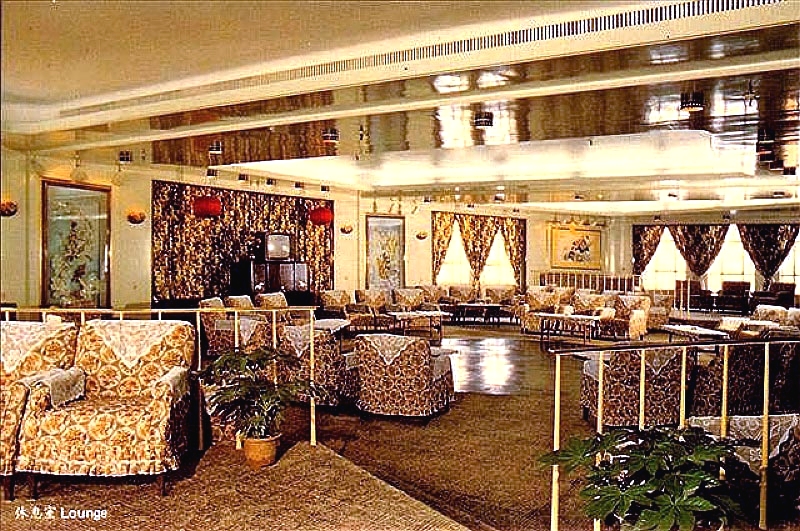
Above
& below:
The
Main Lounge had been completely refurbished. The hardware is the
same
Just
the software and artworks have been changed to suit Chinese
tastes
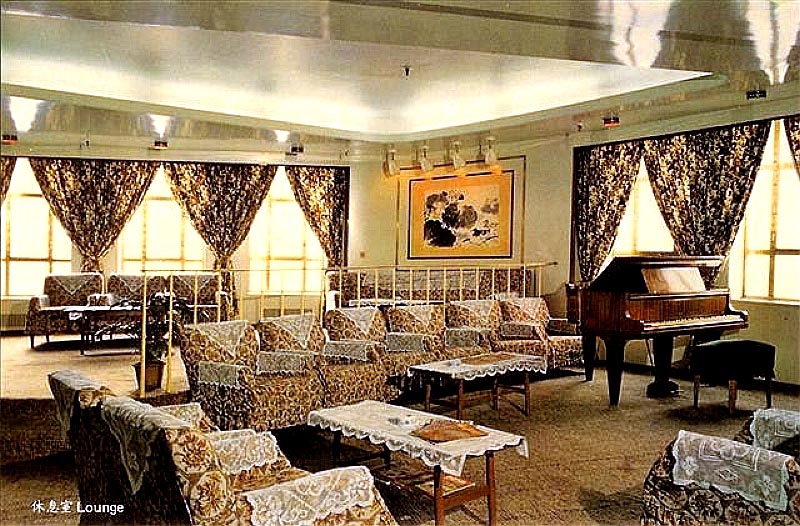

The
Bar, known as the “Snack Bar”

The
Smoking Room and the Café
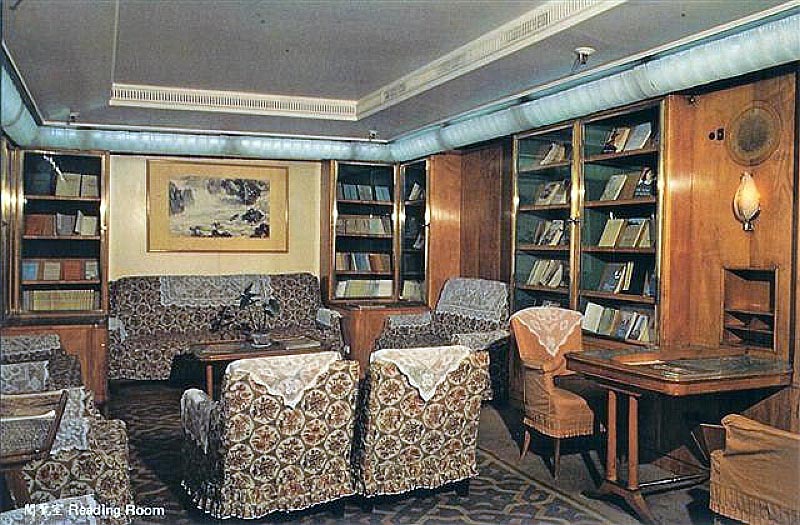
The
Reading & Writing Room and Library
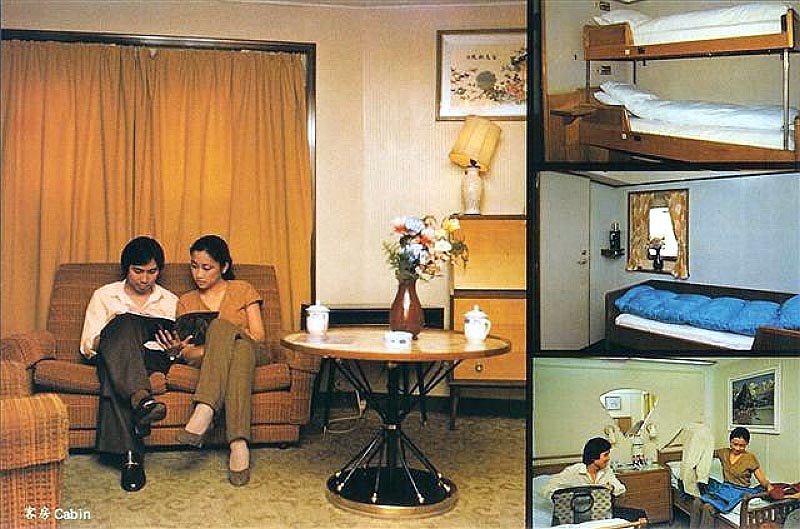
A
range of accommodations, a Suite, two berth, a single bed and a
twin bedded cabin
All
cabins had private facilities and mod-cons, but were relatively
simple when it came to décor
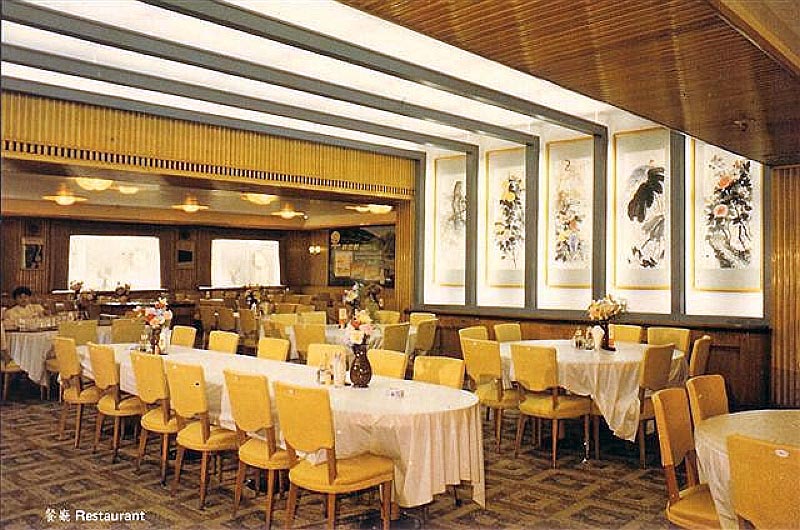
Then
Restaurant the only venue that remained very much unchanged
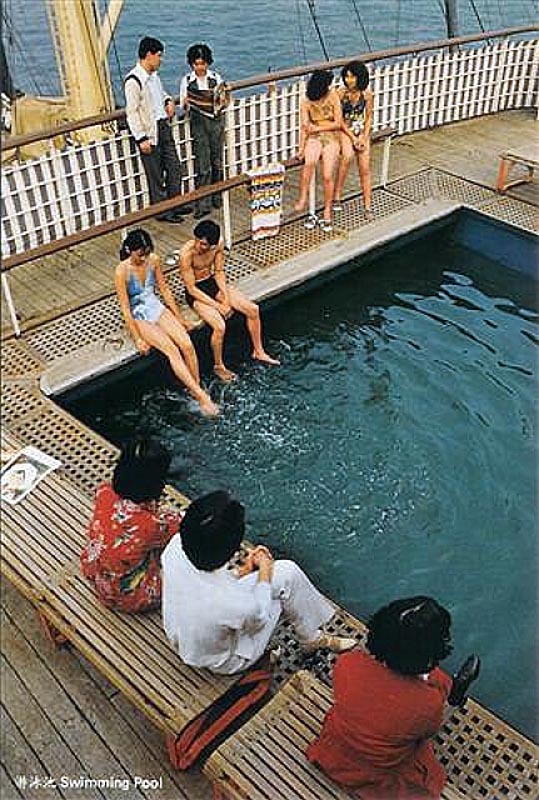
The
Swimming Pool
Later the Shanghai was painted all white again
and continued sailing, but when she was seen in 1993, she was
certainly looking somewhat the worse for wear, but at least she
was still in operation and she continued until she was finally
sold in 1996 to be broken up.
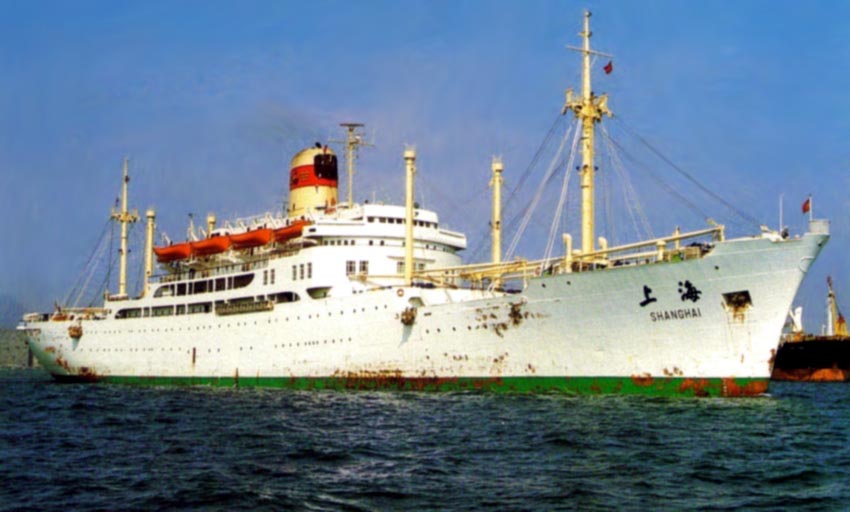
This fine ship and her superb steam engine
which together with the ship itself were built by one of the
greatest shipyards in the world - “Chantiers de
Penoët” at St Nazaire in France and she certainly had an
outstanding and a long career behind her and nothing better can
be said than that! Except, that her passengers simply loved the
SS Cathay and yes also her sister the Chitral when they were both
in service with P&O and E&ASSCo’s for they were
indeed exceptional ships, it was just a pity that the Chitral had
those engine and terrible fuel problems,. If it had only been
built in France and not by her builder!!
Memories
of a Wonderful Belgium Congo Liner …
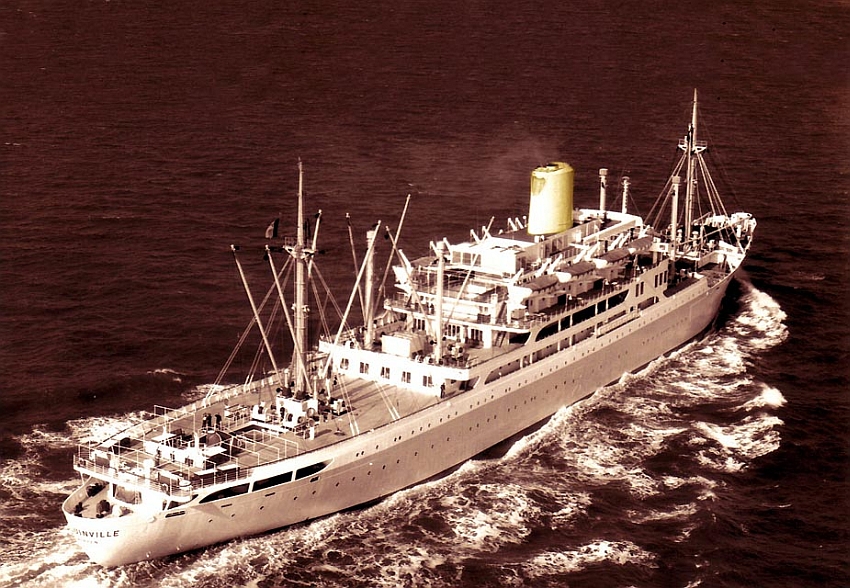
The
wonderful SS Baudouinville III is seen from the air just after
she was built
A
great Belgium ship that became the SS Cathay and the SS Shanghai!
View
of amazing SS Chitral Page Two
This
Page Features; Interior Photographs, Menus and a Deck Plan!
****************************
The
following are related pages to the earlier Belgium Congo ships
Read
the MV Baudouinville II story
Also
the SS
Charlesville feature
Covering
all the “Albertville Class” Ships
“Blue
Water Liners sailing to the distant shores.
I watched them come, I watched them go and I watched them
die.”
****************************
Visit our ssMaritime
Main INDEX
Where
you will discover around 680 Classic Passenger &
Passenger-Cargo Liners!
ssMaritime.com & ssMaritime.net
Where
the ships of the past make history & the 1914 built MV Doulos
Story
Please
Note: ssmaritime and associated sites are 100% non-commercial
and the author does not seek funding or favours and never have
and never will.
Photographs
on ssmaritime and associate pages are either by the author or
from the author’s private collection. In addition there are
some images and photographs that have been provided by Shipping
Companies or private photographers or collectors. Credit is given
to all contributors, however, there are some photographs provided
to me without details regarding the photographer or owner
concerned. Therefore, I hereby invite if owners of these images
would be so kind to make them-selves known to me (my email
address can be found at the bottom of the page on www.ssmaritime.com), in order that due credit
may be given.
ssMaritime
is owned & © Copyright by Reuben Goossens - All Rights
Reserved.






























